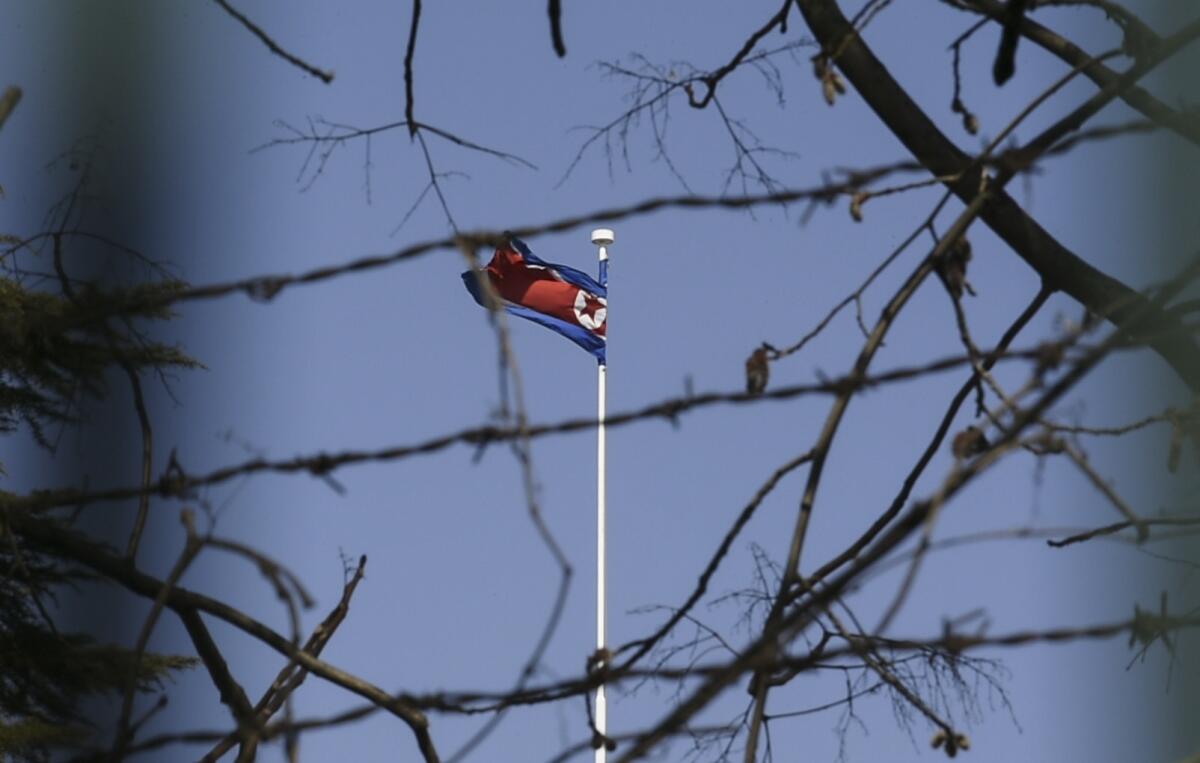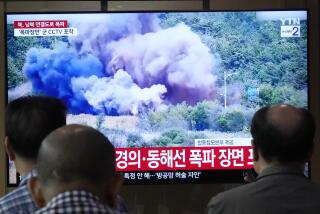Trump administration warns North Korea against provocation

Reporting from Washington — Pivoting off what the White House considers a successful U.S. missile strike in Syria, the Trump administration sent a not-so-subtle message Sunday to North Korea: Don’t risk being next.
With growing signs that Pyongyang may be preparing a sixth nuclear test, a U.S. aircraft carrier strike force near Singapore was diverted north toward the Korean peninsula, President Trump spoke to leaders in Tokyo and Seoul, and senior administration officials made pointed note of the “full range of options” available to counter threats to the United States or its allies.
The sudden flurry of action centering on North Korea comes on the heels of Trump’s summit in Florida on Friday with Chinese President Xi Jinping. The two leaders publicly played down their economic and political disputes and addressed their common interest in reining in North Korea’s mercurial leader, Kim Jong Un.
Pyongyang has repeatedly warned that it aims to test an intercontinental ballistic missile or conduct another underground nuclear test. Analysts say one could come as soon as April 15, the 105th birthday of North Korea’s founding president and celebrated annually as the Day of the Sun.
The spotlight’s turn from Syria to North Korea carries benefits as well as risks for the Trump administration, now nearing its 100-day mark.
With a limited but decisive response to Syrian President Bashar Assad’s alleged use of banned sarin nerve gas on Syrian civilians, Trump won plaudits from previously skeptical U.S. allies in Europe, as well as from some of his harshest critics at home.
But even as Trump basked in generally favorable reviews of the first direct U.S. military strike aimed at Assad, the president and his lieutenants seemed far less eager to engage knotty longer-term policy questions about the grinding multi-sided Syrian war, now in its seventh year.
With North Korea, the underlying issues are just as complex, but the threat of a nuclear conflict — or even a devastating conventional military attack on South Korea and Japan — makes the stakes far higher.
Perhaps mindful of parallels that could be drawn over defiance of international norms, North Korea denounced the U.S. missile strike on Syria as “intolerable,” and reiterated its own right to self-defense.
The U.S. Navy’s Third Fleet, in turn, publicly announced that the Nimitz-class aircraft carrier Carl Vinson and a strike force that includes two missile destroyers and a guided-missile cruiser were being diverted north from scheduled port calls in Australia to “maintain readiness and presence in the western Pacific.”
“The number one threat in the region continues to be North Korea due to its reckless, irresponsible and destabilizing program of missile tests and pursuit of a nuclear weapons capability,” U.S. Pacific Command spokesman Dave Benham told reporters.
North Korea has a long history of defying United Nations resolutions and other attempts to prevent it from developing nuclear arms in conjunction with its growing ballistic-missile capabilities.
Kim’s government has conducted five underground nuclear tests, two of them in 2016, and is working to develop intercontinental ballistic missiles that ultimately could deliver a warhead to U.S. territory.
“If we judge that they have perfected that type of delivery system, then that becomes a very serious stage of their further development,” Secretary of State Rex Tillerson said Sunday on ABC’s “This Week.”
At closer range, Japan has been rattled by North Korea’s repeated recent test-firings of short- and medium-range ballistic missiles in its direction, the latest just two days before Trump sat down with Xi.
That test came a month after Pyongyang simultaneously launched four medium-range missiles into the ocean in what it said was proof it could hit U.S. military bases in Japan.
Japanese Prime Minister Shinzo Abe, seeking assurances of U.S. protection, was an early visitor to both the White House and Trump’s Florida resort Mar-a-Lago.
On Sunday, the White House announced that Trump had spoken by phone with Abe about Syria and “a range of regional issues, including the threat posed by North Korea.” A similar phone call took place Friday with South Korea’s acting president, Hwang Kyo-ahn, the White House said.
Adding to the barrage of cautionary language aimed at Pyongyang, Tillerson framed the Syria missile strike as a more general warning against international outliers, even those whose actions did not pose a direct security threat to the U.S.
“If you violate international agreements, if you fail to live up to commitments, if you become a threat to others, at some point a response is likely to be undertaken,” he said.
The White House national security advisor, Lt. Gen. H.R. McMaster, cited a “pattern of provocative behavior” on North Korea’s part.
“This is a rogue regime that is now a nuclear-capable regime,” he said on “Fox News Sunday.”
McMaster said that Trump had asked aides to prepare “a full range of options to remove that threat to the American people and to our allies and partners in the region.”
North Korea, for its part, denounced what it called Washington’s “reckless moves” toward war, according to a statement carried by its official Korean Central News Agency.
ALSO
China’s President Xi gets an awkward front-row seat to U.S. military might
Syria crisis tests Trump’s plan for a new world order
Can the U.S. defend against a North Korean missile strike?
More to Read
Sign up for Essential California
The most important California stories and recommendations in your inbox every morning.
You may occasionally receive promotional content from the Los Angeles Times.










